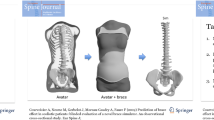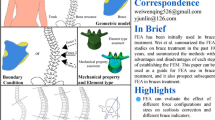Abstract
Purpose
Personalized modeling of brace action has potential in improving brace efficacy in adolescent idiopathic scoliosis (AIS). Model validation and simulation uncertainty are rarely addressed, limiting the clinical implementation of personalized models. We hypothesized that a thorough validation of a personalized finite element model (FEM) of brace action would highlight potential means of improving the model.
Methods
Forty-two AIS patients were included retrospectively and prospectively. Personalized FEMs of pelvis, spine and ribcage were built from stereoradiographies. Brace action was simulated through soft cylindrical pads acting on the ribcage and through displacements applied to key vertebrae. Simulation root mean squared errors (RMSEs) were calculated by comparison with the actual brace action (quantified through clinical indices, vertebral positions and orientations) observed in in-brace stereoradiographies.
Results
Simulation RMSEs of Cobb angle and vertebral apical axial rotation was lower than measurement uncertainty in 79 % of the patients. Pooling all patients and clinical indices, 87 % of the indices had lower RMSEs than the measurement uncertainty.
Conclusions
In-depth analysis suggests that personalization of spinal functional units mechanical properties could improve the simulation’s accuracy, but the model gave good results, thus justifying further research on its clinical application.




Similar content being viewed by others
References
Dubousset J (1994) Three-dimensional analysis of the scoliotic deformity. In: Weinstein SL (ed) The pediatric spine: principles and practice. Raven Press Ltd, New york
Asher M, Burton D (2006) Adolescent idiopathic scoliosis: natural history and long term treatment effects. Scoliosis 1:2
Weinstein SL, Dolan LA, Wright JG, Dobbs MB (2013) Effects of bracing in adolescents with idiopathic scoliosis. New Engl J Med 369:1512–1521. doi:10.1056/NEJMoa1307337
Lou EM, Hill D, Raso J, Moreau M, Hedden D (2015) How quantity and quality of brace wear affect the brace treatment outcomes for AIS. Eur Spine J. doi:10.1007/s00586-015-4233-2
Courvoisier A, Drevelle X, Vialle R, Dubousset J, Skalli W (2013) 3D analysis of brace treatment in idiopathic scoliosis. Eur Spine J 22:2449–2455. doi:10.1007/s00586-013-2881-7
Jalalian A, Gibson I, Tay EH (2013) Computational biomechanical modeling of scoliotic spine: challenges and opportunities. Spine Deform 1:401–411. doi:10.1016/j.jspd.2013.07.009
Wang W, Baran GR, Betz RR, Samdani AF, Pahys JM, Cahill PJ (2014) The use of finite element models to assist understanding and treatment for scoliosis: a review paper. Spine Deform 2:10–27. doi:10.1016/j.jspd.2013.09.007
Aubert B, Vergari C, Ilharreborde B, Courvoisier A, Skalli W (2016) 3-D Reconstruction of rib cage geometry from biplanar radiographs using a statistical parametric model approach. Comput Methods Biomech Biomed Eng Imaging Vis. doi:10.1080/21681163.2014.913990
Humbert L, De Guise JA, Aubert B, Godbout B, Skalli W (2009) 3-D reconstruction of the spine from biplanar X-rays using parametric models based on transversal and longitudinal inferences. Med Eng Phys 31:681–687. doi:10.1016/j.medengphy.2009.01.003
Cobetto N, Aubin CE, Clin J, Le May S, Desbiens-Blais F, Labelle H, Parent S (2014) Braces optimized with computer-assisted design and simulations are lighter, more comfortable, and more efficient than plaster-cast braces for the treatment of adolescent idiopathic scoliosis. Spine Deform 2:276–284. doi:10.1016/j.jspd.2014.03.005
Gignac D, Aubin CÉ, Dansereau J, Labelle H (2000) Optimization method for 3-D bracing correction of scoliosis using a finite element model. Eur Spine J 9:185–190. doi:10.1007/s005860000135
Desbiens-Blais F, Clin J, Parent S, Labelle H, Aubin CE (2012) New brace design combining CAD/CAM and biomechanical simulation for the treatment of adolescent idiopathic scoliosis. Clin Biomech 27:999–1005. doi:10.1016/j.clinbiomech.2012.08.006
Vergari C, Ribes G, Aubert B, Adam C, Miladi L, Ilharreborde B, Abelin-Genevois K, Rouch P, Skalli W (2015) Evaluation of a patient-specific finite element model to simulate conservative treatment in adolescent idiopathic scoliosis. Spine Deform 3:4–11. doi:10.1016/j.jspd.2014.06.014
Steffen JS, Obeid I, Aurouer N, Hauger O, Vital JM, Dubousset J, Skalli W (2010) 3-D postural balance with regard to gravity line: an evaluation in the transversal plane on 93 patients and 23 asymptomatic volunteers. Eur Spine J 19:760–767. doi:10.1007/s00586-009-1249-5
Mitton D, Deschênes S, Laporte S, Godbout B, Bertrand S, de Guise JA, Skalli W (2006) 3-D reconstruction of the pelvis from bi-planar radiography. Comput Methods Biomech Biomed Eng 9:1–5. doi:10.1080/10255840500521786
Descrimes JL, Aubin CE, Skalli W, Zeller R, Danserau J, Lavaste F (1995) Introduction des facettes articulaires dans une modélisation par éléments finis de la colonne vertébrale et du thorax scoliotique: aspects mécaniques. Rachis 7:301–314
Pezowicz C, Glowacki M (2012) The mechanical properties of human ribs in young adult. Acta of bioengineering and biomechanics 14:53–60
Sandoz B, Badina A, Laporte S, Lambot K, Mitton D, Skalli W (2013) Quantitative geometric analysis of rib, costal cartilage and sternum from childhood to teenagehood. Med Biol Eng Comput 51:971–979. doi:10.1007/s11517-013-1070-5
Nérot A, Choisne J, Amabile C, Travert C, Pillet H, Wang X, Skalli W (2015) A 3-D reconstruction method of the body envelope from biplanar X-rays: evaluation of its accuracy and reliability. J Biomech 48:4322–4326. doi:10.1016/j.jbiomech.2015.10.044
Lebel D, Al-Aubaidi Z, Shin EJ, Howard A, Zeller R (2013) Three-dimensional analysis of brace biomechanical efficacy for patients with AIS. Eur Spine J 22:2445–2448. doi:10.1007/s00586-013-2921-3
Malfair D, Flemming AK, Dvorak MF, Munk PL, Vertinsky AT, Heran MK, Graeb DA (2010) Radiographic evaluation of scoliosis: review. Am J Roentgenol 194:S8–S22. doi:10.2214/AJR.07.7145
Schwab FJ, Lafage V, Farcy JP, Bridwell KH, Glassman S, Shainline MR (2008) Predicting outcome and complications in the surgical treatment of adult scoliosis. Spine 33:2243–2247. doi:10.1097/BRS.0b013e31817d1d4e
Vergari C, Dubois G, Vialle R, Gennisson JL, Tanter M, Dubousset J, Rouch P, Skalli W (2016) Lumbar annulus fibrosus biomechanical characterization in healthy children by ultrasound shear wave elastography. Eur Radiol 26:1213–1217. doi:10.1007/s00330-015-3911-0
Lafon Y, Lafage V, Steib JP, Dubousset J, Skalli W (2010) In vivo distribution of spinal intervertebral stiffness based on clinical flexibility tests. Spine 35:186–193. doi:10.1097/BRS.0b013e3181b664b1
Little JP, Adam CJ (2009) The effect of soft tissue properties on spinal flexibility in scoliosis: biomechanical simulation of fulcrum bending. Spine 34:E76–E82. doi:10.1097/BRS.0b013e31818ad584
Acknowledgments
The authors are grateful to the ParisTech BiomecAM chair program on subject-specific musculoskeletal modeling (with the support of ParisTech and Yves Cotrel Foundations, Société Générale, Proteor and Covea) and to the “Investissements d’Avenir” program for funding the CORSIN Project, in collaboration between Proteor and our institution. We would also like to thank Ms Sonia Simoes for her technical help.
Author information
Authors and Affiliations
Corresponding author
Ethics declarations
Conflict of interest
No conflict of interest to disclose.
Electronic supplementary material
Below is the link to the electronic supplementary material.
Rights and permissions
About this article
Cite this article
Vergari, C., Courtois, I., Ebermeyer, E. et al. Experimental validation of a patient-specific model of orthotic action in adolescent idiopathic scoliosis. Eur Spine J 25, 3049–3055 (2016). https://doi.org/10.1007/s00586-016-4511-7
Received:
Revised:
Accepted:
Published:
Issue Date:
DOI: https://doi.org/10.1007/s00586-016-4511-7




